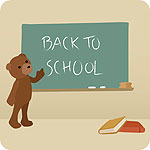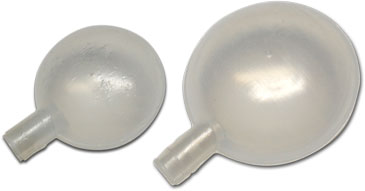Back to Basics, Part 2
 Our 'Back to Basics' section provides ongoing useful hints to enhance your bearmaking experience and this week we explain how getting it right in the beginning, by making a good set of templates, is a step in the right direction...
Our 'Back to Basics' section provides ongoing useful hints to enhance your bearmaking experience and this week we explain how getting it right in the beginning, by making a good set of templates, is a step in the right direction...
Templates
In bearmaking, a template is a copy of the original pattern, enabling you to reproduce or transfer those shapes to fabric. Accuracy plays a vital role in making templates, and just as important, is the transferring of the shape from your template to your fabric.
What can templates be made from?
As we like to 'recycle, reduce and re-use', we use empty cereal boxes, old folders or files – anything that is not too rigid, but that has some firmness to it, making it easy to trace around. The easiest way is to glue your pattern on to the board and carefully cut each shape out with paper scissors. You could also glue a small piece of sandpaper to the back of each shape to prevent it from shifting as you trace the shape on to the fur backing. Another option would be to use a firm, clear plastic sheet, place it over your pattern and, using a permanent marker, transfer the pattern on to the plastic sheet, then cutting out with paper or kitchen scissors.
Duplicate shapes
As you know, several bear pattern pieces are mirror images and need to be 'flipped' when transferring the shapes so you have both left and right limbs, body, side heads etc. Read the information on the pattern sheet and count how many pieces you would need to make in total. Then make it easy on yourself by making a full set of templates, ie all the shapes required, such as two (or four) limb shapes, two side heads, four ears, etc. depending on the design, so when you lay them out on the fabric backing you can determine whether you have sufficient fabric for the pattern you have selected.
File your templates
If you make an accurate, sturdy set of templates you will be able to use them again and again. So it makes sense to also file them where you have easy access to them. A ziplock bag and/or clear plastic sleeves are perfect for storing your templates as well as the original pattern, instructions and cover with the image of the bear. Finally, don't forget to alphabetically label and date them.


 What ever happened to Hopkin Hare, you may ask? Swifter than a rabbit and with longer limbs, he's been hopping all over the place, reluctant to settle down with the Toybox Teddies and Friends, despite our initial assurances he would be 'refined and genteel'! Unable to catch him to get his photograph taken we're planning on getting him cornered soon (and just wait until the 'gang' gets hold of him!). So keep your eyes peeled!
What ever happened to Hopkin Hare, you may ask? Swifter than a rabbit and with longer limbs, he's been hopping all over the place, reluctant to settle down with the Toybox Teddies and Friends, despite our initial assurances he would be 'refined and genteel'! Unable to catch him to get his photograph taken we're planning on getting him cornered soon (and just wait until the 'gang' gets hold of him!). So keep your eyes peeled!